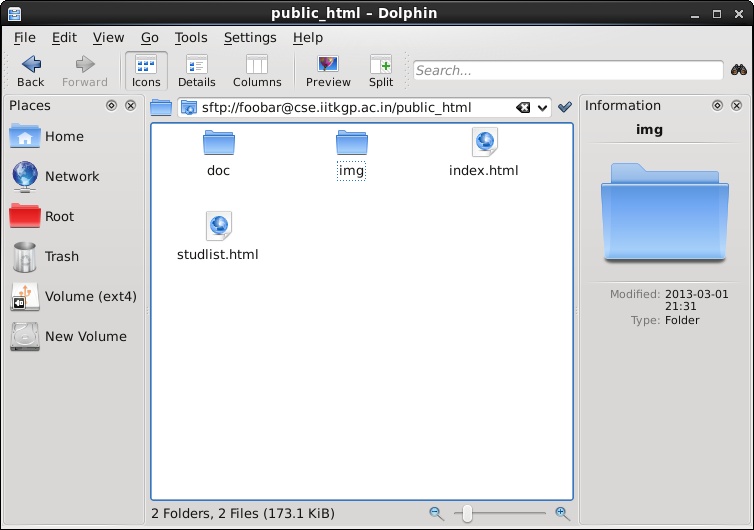Using the account manager web interface /* The medieval way */
This service has been discontinued from January 2013.
Using sftp /* The assembly-language way */
You can also use sftp to upload your files (particularly, large ones). A sample session follows.
[localmc]/home/foobar> sftp foobar@cse.iitkgp.ac.in foobar@cse.iitkgp.ac.in's password: [Enter your password here, will not be echoed] Connected to cse.iitkgp.ac.in. sftp> pwd Remote working directory: / sftp> ls public_html tmp sftp> cd public_html sftp> ls img index.html studlist.html sftp> mkdir doc sftp> ls doc img index.html studlist.html sftp> put myprog.c Uploading myprog.c to /public_html/myprog.c myprog.c 100% 766 0.8KB/s 00:00 sftp> ls doc myprog.c img index.html studlist.html sftp> rm myprog.c Removing /public_html/myprog.c sftp> dir doc img index.html studlist.html sftp> bye [localmc]/home/foobar>
Please note that you are not allowed to move up from your home directory. However, you can do whatever you want under your home. Any remote shell access is denied. That is, telnet or ssh will not work. scp will also not work. Sorry for the inconvenience.
Using sshfs /* The high-level language way */
A neat and user-friendly interface to sftp is provided by sshfs or any graphic interface of this. Here is how you can use this feature from your local shell.
# Create a (blank) directory somewhere in your local file system [localmc]/home/foobar> mkdir -m 755 csemount [localmc]/home/foobar> ls -l csemount/ total 0 # Mount your public_html directory of cse.iitkgp.ac.in in your local file system. # The mount point is the directory csemount/. [localmc]/home/foobar> sshfs foobar@cse.iitkgp.ac.in:public_html/ csemount/ foobar@cse.iitkgp.ac.in's password: [Enter your password, not to be echoed] [localmc]/home/foobar> ls csemount/ doc/ img/ index.html studlist.html [localmc]/home/foobar> cd csemount/ # Copy a file from your local machine to under the mounted directory [localmc]/home/foobar/csemount> cp ../Foobar-paper-Dec11.pdf doc/ [localmc]/home/foobar/csemount> ls doc/ Foobar-paper-Dec11.pdf # Now unpack an archive in the mounted area [localmc]/home/foobar/csemount> tar xvzf ~/IITKGP/slide.tgz slide/ slide/sample.ps slide/.xvpics/ slide/.xvpics/iitkgplogo.ps slide/colordef.sty slide/sample.aux slide/sample.tex slide/sample.dvi slide/sample.log slide/iitkgplogo.ps slide/iitkgplogo.jpg slide/iitkgpslide.sty slide/sample slide/sample.pdf [localmc]/home/foobar/csemount> ls doc/ img/ index.html slide/ studlist.html [localmc]/home/foobar/csemount> cd slide/ [localmc]/home/abhij/csemount/slide> ls colordef.sty iitkgplogo.ps sample sample.dvi sample.pdf sample.tex iitkgplogo.jpg iitkgpslide.sty sample.aux sample.log sample.ps [localmc]/home/foobar/csemount/slide> cd .. [localmc]/home/foobar/csemount/> rm -rf slide/ [localmc]/home/foobar/csemount> ls doc/ img/ index.html studlist.html # You are done for the time being [localmc]/home/foobar/csemount> cd # Unmount the remote file system [localmc]/home/foobar> fusermount -u csemount/ [localmc]/home/foobar> ls -l csemount/ total 0 [localmc]/home/foobar>
Using Gnome's "Connect to Server" /* The engineer's (read as "lazy" or "prudent") way */
You can run the utility nautilus-connect-server which supports drag-and-drop facilities. Here is a demonstration of how the GUI works.

The login window

The password window

The remote location window
The rest is obvious.
If the eject button does not appear in your utility, you are likely to find a new connection icon on your computer's desktop. Disconnect the session using that icon. What if you use a non-Linux OS? Search for sftp clients in the net, suitable for your desktop.
Using Other File Managers /* Another "lazy" or "prudent" way */
Many file managers (like dolphin) support sftp. Type sftp://loginid@cse.iitkgp.ac.in/ at the location to open. Hit return. The file manager will ask for your password. After you log in, you can use copy-paste and drag-and-drop facilities. A window dump for a sample session is given below.
